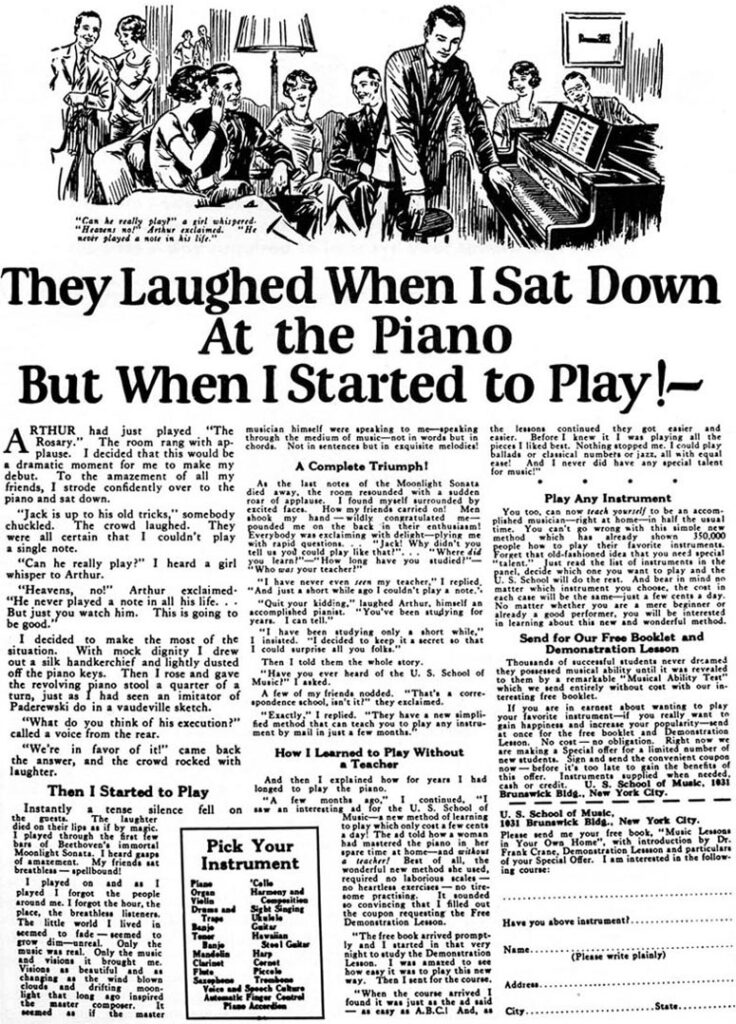Iconic Ads: US School of Music – They Laughed When

This direct marketing advertisement became one the most famous and also the most imitated advertisements of all time
The direct marketing movement had its stars, and undoubtedly John Caples was one of the early ones. Caples was the genius behind the most famous direct mail marketing of all time, which read: “They laughed when I sat down at the piano, but when I started to play!”
When Caples wrote the famous advertisement for the US School of Music home-study course in 1925, he was a first-year writer at Ruthrauff & Ryan in New York.
As a copywriter who was starting, Caples came up with several headline ideas and presented them to his supervisor. These were a handful. Some of them were:
- “Can you play the piano? Neither could I three months ago.”
- “They laughed when I sat down at the piano. But when I started to play…”
- “I never saw my music teacher. But he taught me to play just the same.”
- “Give me 10 minutes, and I’ll prove you can learn music without a teacher.”
Caples’ boss chose the now-famous line. His boss took a glance at the headlines and then crossed out the one that starts with ‘They laughed. He then instructed Caples to “provide a copy to accompany that headline.”
Below that headline, Caples penned four pages of text that were single-spaced.

In the long-copy advertisement, Jack surprises his pals, who believed he couldn’t play an instrument, by playing Beethoven’s Moonlight Sonata at a musical event.
The first thing that Caples realised when he was creating the ad was that it wasn’t only about selling lessons to those who couldn’t play the instrument. Instead, he drew in viewers by appealing to their emotions. The ad’s protagonist, a young boy who had no one to believe in him, experiences a surge of pride after mastering the piano, and viewers are inspired to seek out similar opportunities for personal growth (“Maybe I can learn how to play the piano, and that can be me!”).
John Caples realised that the words on a mailer were crucial to its open rate and, by extension, the campaign’s success or failure.
The subject line of an email still plays a significant role in determining its open rate, almost a century after its creation.
Even though Caples lacked any research training, he was a pioneer in the movement to determine how advertisements were successful. He paid close attention to the advertising placement, size, colour, and language.
Caples realised that the text on the inside would determine whether or not the homeowner responded. Just like we performed split testing today, he went with the version of the copy that sold better after testing it.
Even though his approaches were mocked at first, they were later regarded as essential for campaign planning and testing.
”Only half the people in our nation have a sense of humour, and creative commercials rarely sell anything,” he said, disproving witty advertising material. ” Additionally, he suggested that copywriters “use words you would expect to find in a fifth-grade reader” because “the average American is approximately thirteen years old mentally.”
Upon its publication in Physical Culture magazine, the advertisement achieved unprecedented success, selling more coupons than ever before. It was widely replicated after running for a while in different newspapers.
U.S. School of Music home study courses were sold in droves by that copy. It went on to become one of the most famous (and imitated) advertisements of all time.




1 Comment